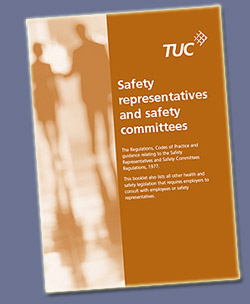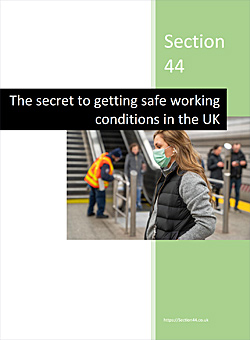 |
|
|
|
Protects Union Safety Reps From Recrimination By Their Employer Protects Individual Workers Against Employer Recriminations Section 44 Employment Rights Act 1996 as amended by the Employment Rights Act 1996 (Protection from Detriment in Health and Safety Cases) (Amendment) Order 2021, which came into force on 31st May 2021, could be considered the corner stone of the UK’s Health & Safety at Work legislation, and yet very few Trade Unions and Union Safety Reps appear to be aware of its existence. The amended Act, changed the term ’employee’ to be ‘worker’. Thus, expanding the range of people covered by section 44 to include, agency and part-time staff, (including zero hours contracts) and volunteers, etc.
Given that major employers and Blue Chip companies are busy along with the CBI, in attacking workers rights and in many cases TRade Union members and their Union Safety Reps by taking punitive action, using health & safety as an excuse by blaming USRs for the state of the company's buildings, and by taking disciplinary action against those having accidents at work and blaming them; and to dismissing USRs who have raised serious issues that risk the Health & Safety of employees and indeed managers. The CBI are currently lobbying the Labour Party leaders at Westminster, according to media reports, to water down existing employment rights, including that of workplace health and safety legislation.
But the way to fight back is to use existing legislation when facing problems from the employer: Union Safety Reps have the Brown Book, which is the legislation that is specific to Safety Reps and Safety Committees aka, Safety Representatives and Safety Committees Regulations 1977 which can be downloaded directly from the Unionsafety E-Library or by clicking on the image of its cover on the left. But both USRs AND IR Reps as well as individual employees have the protection too, of the Employment Rights Act 1996 So what is all the fuss about? What is the Employment Rights Act 1996? As explained on the Section 44 website, Section 44 Employment Rights Act 1996 could be considered the corner stone of the UK’s Health & Safety at Work legislation. In terms of Health & Safety protection, the Act can be used to protect Union Safety Reps alongside the specifics of the Safety Representatives and Safety Committees Regulations 1977, because: Section 44. provides workers with the means to contest the adequacy and/or suitability of safety arrangements without fear of recriminations (e.g. getting sacked or transferred) or suffering detriment (e.g. loss of wages). Section 44. provides workers with the ‘right’ to withdraw from and to refuse to return to a workplace that is unsafe. Workers are entitled to remain away from the workplace (e.g. stay at home) if – in their opinion – the prevailing circumstances represent a real risk of serious and imminent danger which they could not be expected to avert. Section 44. entitles workers to claim for ‘Constructive Dismissal’ and (unlimited) compensation in the event that an employer fails to maintain safe working conditions. Section 44. means workers don’t have to wait until they (or someone else) suffer injury before they can take action to get suitably safe working conditions. Section 44. leaves workers with no excuse whatsoever for tolerating unsafe working conditions and acts as a deterrent against an employer either deliberately or carelessly devoting inadequate resources to the protection of safety in their workplace.
The Act equally applies to anyone whose workplace is outdoors, in a work van, delivery by vehicle and or by foot. For example, not providing the correct street works guarding, APPROPRIATE SIGNAGE warning vehicles of the work, providing inappropriate equipment such as A-Frame ladders to staff installing cables across roads, no signage and expecting staff to stand in the way of traffic to stop as the cable is manually suspended above the road. Ducting work without appropriate equipment and Personal Protective Equipment, signage and coverage from rain. In essence wherever health & safety of the employee needs to be assessed via risk assessments, or of course when they are not carried out prior to the work being done and with the consideration of the specific work area involved, and where the work is to be done and when. The right to appropriate personal hygiene consideration for example washing and toilet facilities for those working outside and or delivering goods and services. But ne of the most important elements of the Act, is that it provides the work with the following rights: Section 44. cautions workers against taking risksSection 44. clarifies the circumstances in which a worker should take “appropriate action” to withdraw/remove themselves from danger. See Section 44.1(d) and Section 44.1(e) below: (d) in circumstances of danger which the worker reasonably believed to be serious and imminent and which he could not reasonably have been expected to avert, he left (or proposed to leave) or (while the danger persisted) refused to return to his place of work or any dangerous part of his place of work, or (e) in circumstances of danger which the worker reasonably believed to be serious and imminent, he took (or proposed to take) appropriate steps to protect himself or other persons from the danger. Section 44. clarifies that it is the individual worker’s opinion that countsSection 44.2 makes it clear that it’s what the individual worker taking the action believes that counts – Section 44.2 For the purposes of subsection (1)(e) whether steps which a worker took (or proposed to take) were appropriate is to be judged by reference to all the circumstances including, in particular, his knowledge and the facilities and advice available to him at the time.
Source: Unionsafety / Section 44 / UK Gov Legislation / Financial Times / Institute of Employment Rights
|

 Unionsafety has promoted Section 44 for several years with the home page link to the document and dedicated website, through the front page logo to the right of this news item.
Unionsafety has promoted Section 44 for several years with the home page link to the document and dedicated website, through the front page logo to the right of this news item.

